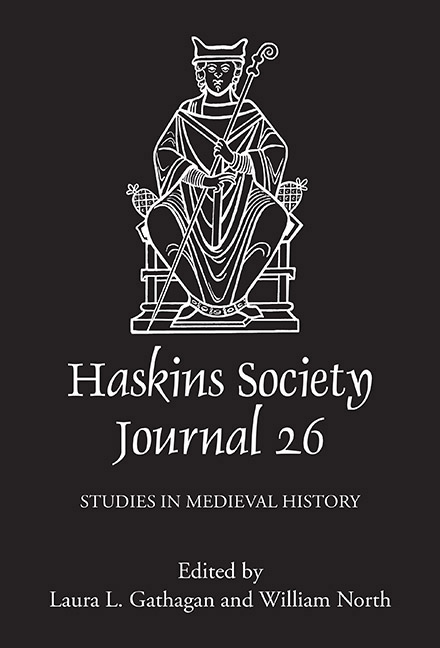Book contents
- Frontmatter
- Contents
- List of Figures
- Editors’ Note
- Abbreviations
- 1 Mores Tuos Fabricae Loquuntur Building Activity and the Rhetoric of Power in Ostrogothic Italy
- 2 A Hermeneutical Feast: Interreligious Dining in Early Medieval Conciliar Legislation
- 3 A Hypothetical Slave in Constantinople: Amalarius’s Liber Officialis and the Mediterranean Slave Trade
- 4 Welsh Kings at Anglo-Saxon Royal Assemblies (928–55)
- 5 The Diplomatics of Depredation: Reconsidering Holy Trinity Caen’s List of Losses
- 6 When Did Robert of Torigni First Receive Henry of Huntingdon’s Historia Anglorum, and Why Does It Matter?
- 7 A Coin Bearing Testimony to Duchess Matilda as Consors Regni
- 8 Fighting to be the Tallest Dwarf: Invidia and Competition in the Self-Conception of Eleventh- and Twelfth-Century Masters
- 9 Brut y Tywysogion: the History of the Princes and Twelfth-Century Cambro-Latin Historical Writing
- 10 The Use of English Annalistic Sources in Medieval Welsh Chronicles
- 11 A Franco-Danish Marriage and the Plot against England
5 - The Diplomatics of Depredation: Reconsidering Holy Trinity Caen’s List of Losses
Published online by Cambridge University Press: 25 May 2021
- Frontmatter
- Contents
- List of Figures
- Editors’ Note
- Abbreviations
- 1 Mores Tuos Fabricae Loquuntur Building Activity and the Rhetoric of Power in Ostrogothic Italy
- 2 A Hermeneutical Feast: Interreligious Dining in Early Medieval Conciliar Legislation
- 3 A Hypothetical Slave in Constantinople: Amalarius’s Liber Officialis and the Mediterranean Slave Trade
- 4 Welsh Kings at Anglo-Saxon Royal Assemblies (928–55)
- 5 The Diplomatics of Depredation: Reconsidering Holy Trinity Caen’s List of Losses
- 6 When Did Robert of Torigni First Receive Henry of Huntingdon’s Historia Anglorum, and Why Does It Matter?
- 7 A Coin Bearing Testimony to Duchess Matilda as Consors Regni
- 8 Fighting to be the Tallest Dwarf: Invidia and Competition in the Self-Conception of Eleventh- and Twelfth-Century Masters
- 9 Brut y Tywysogion: the History of the Princes and Twelfth-Century Cambro-Latin Historical Writing
- 10 The Use of English Annalistic Sources in Medieval Welsh Chronicles
- 11 A Franco-Danish Marriage and the Plot against England
Summary
After the death of King William, William, count of Evreux, took from Holy Trinity and from the abbess and the nuns seven arpents of vineyard and two horses and twenty sous of the coinage of Rouen and the salt pans of Escanneville and twenty livres annually from Gacé and Bavent…
So begins the list of depredations committed against the nuns of Holy Trinity Caen, a document now preserved only in the early thirteenth-century cartulary of the Norman abbey, and made famous by Charles Homer Haskins when he published it at the very beginning of the chapter of his Norman Institutions on the reign of Robert Curthose, King William's son. This iconic document embodied, in Haskins's mind, the general state of public disorder and anarchy during Curthose's reign. Ducal power was not strong enough to prevent these depredations, the perpetrators of which were not only petty nobles encroaching on the nuns’ possessions, but even the greatest Norman magnates, such as William of Évreux and Count Henry – the future Henry I.
An oft-cited but understudied document?
Charles Haskins was not the first historian to examine this list. G. de La Rue, an early historian of the city of Caen, seems to have been the first to refer to it. Worthy of note is that he cast a critical eye on its context, stressing that the despoliations inflicted on Holy Trinity might have stemmed from the fact that its founder, Duke William, might have given the nuns what he did not own, and which others later claimed. However, the document soon became closely associated only with the received view of Robert's reign as a time of anarchy.
Auguste Le Prévost mentioned it in a footnote of his magisterial edition of Orderic Vitalis's Ecclesiastical History in order to corroborate the Norman monk's depiction of the state of public disorder under Curthose's rule. His aim in using the document was thus close to the way in which Haskins would use it, but the Frenchman did not provide any further comment or even an edition of the Caen text. Neither did his student Léopold Delisle, who, for instance, included it in the appendix of his Études sur la condition de la classe agricole, a compendium of extracts from written evidence, mainly charters and chronicles, that could help contextualize Norman agricultural production.
- Type
- Chapter
- Information
- The Haskins Society Journal 262014. Studies in Medieval History, pp. 123 - 142Publisher: Boydell & BrewerPrint publication year: 2015



